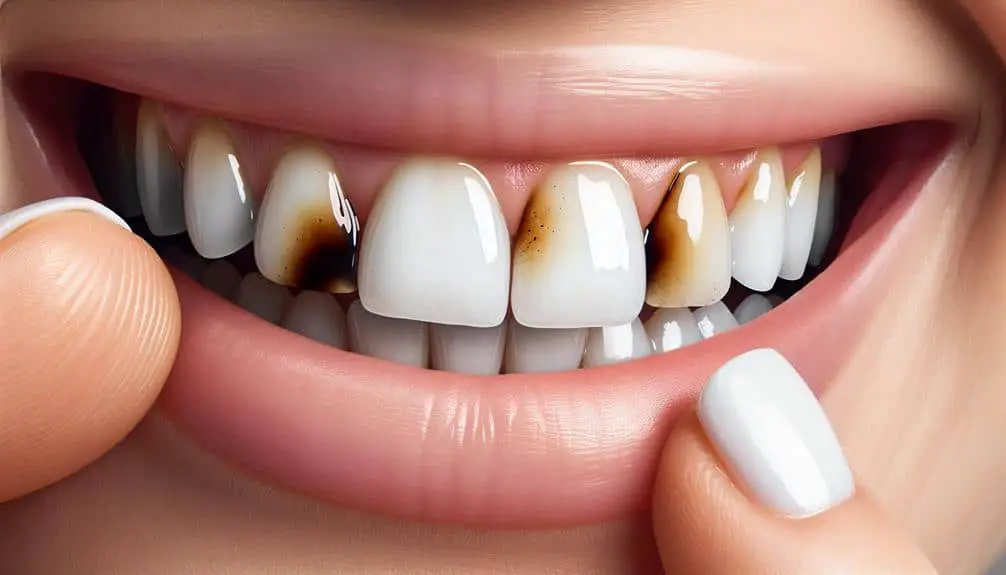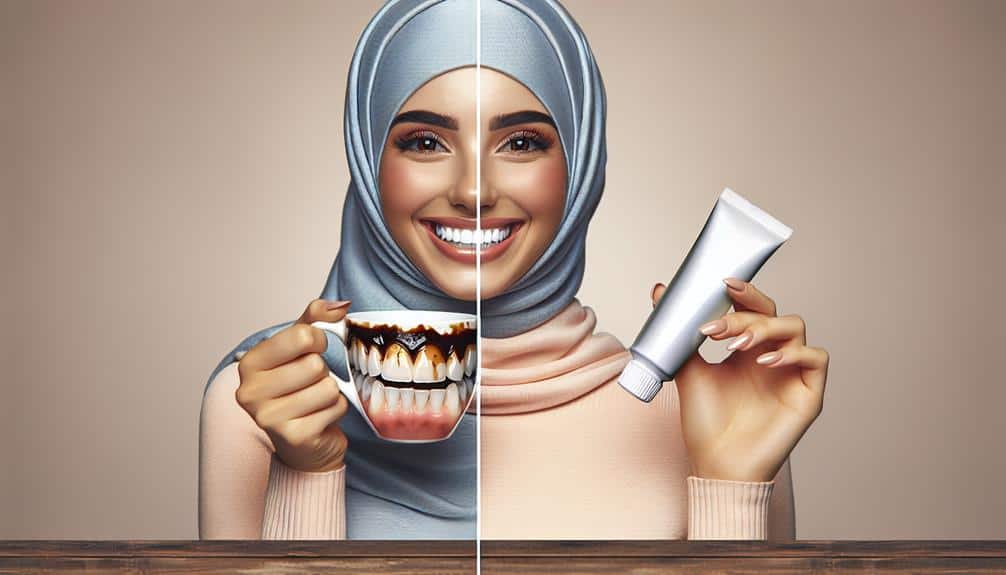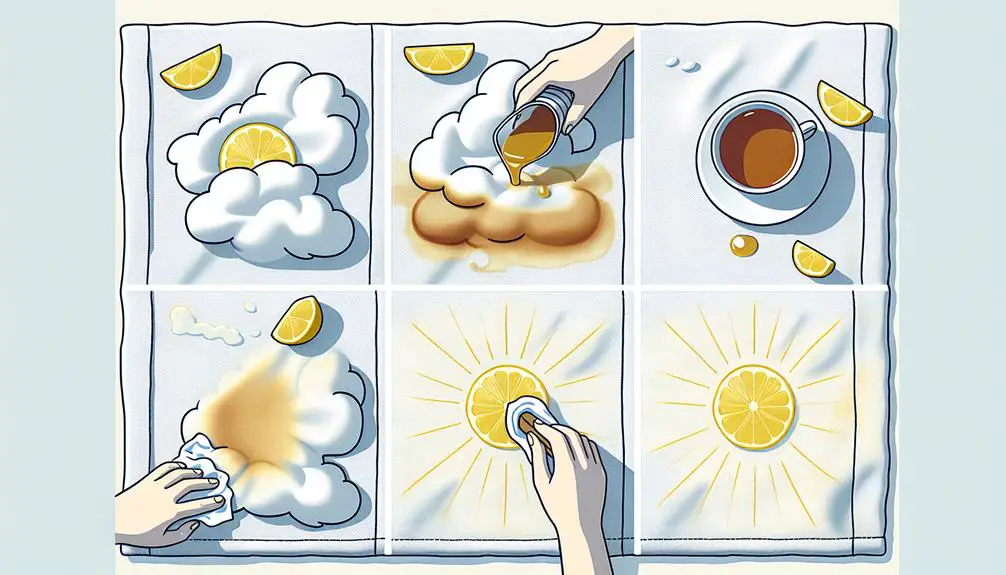To remove tea stains on your teeth, follow these 7 proven tips: Brush teeth thoroughly with a soft-bristled toothbrush and fluoride toothpaste. Focus on stained areas. Try whitening strips for stubborn stains. Use baking soda sparingly to scrub gently. Dilute hydrogen peroxide with water for safe swishing. Consider oil pulling to reduce plaque and gum inflammation. Use diluted apple cider vinegar as a mouthwash. These methods are effective in combating tea stains and promoting oral health. Enhance your smile with these proven tips. Start your journey to a brighter smile today.
Key Points
- Regularly brush with fluoride toothpaste to combat tea stains effectively.
- Use baking soda paste sparingly as a gentle abrasive to remove stains.
- Dilute hydrogen peroxide for safe whitening to break down stubborn stains.
- Incorporate oil pulling to reduce plaque and bacteria for whiter teeth.
- Occasionally use diluted apple cider vinegar as a natural mouthwash for brightening.
Regular Brushing Techniques
To effectively remove tea stains on your teeth, begin by incorporating important brushing techniques into your daily oral care routine. Brush your teeth at least twice a day using a soft-bristled toothbrush and fluoride toothpaste. Make sure to brush each tooth surface gently yet thoroughly, focusing on areas where tea stains are prominent. Additionally, consider using whitening strips to help combat stubborn stains and brighten your smile.
Incorporating proper flossing techniques is also essential in the fight against tea stains. Flossing at least once a day helps remove plaque and debris from between your teeth that brushing alone can't reach. This can prevent tea stains from settling in hard-to-reach areas and maintain overall oral health.
Regular dental cleanings are important for removing built-up stains and keeping your teeth healthy. Professional cleanings can target and eliminate tea stains more effectively than at-home methods. Using a mouthwash with whitening properties can provide additional benefits by freshening your breath and reducing bacteria in your mouth.
Incorporate Baking Soda
Incorporating baking soda into your oral care routine can help effectively remove stubborn tea stains on your teeth. Baking soda benefits oral health by acting as a mild abrasive that can gently scrub away surface stains without causing damage to the enamel.
To utilize this method, create a paste by mixing a small amount of baking soda with water until it forms a thick consistency. Then, apply the paste to your toothbrush and brush your teeth for about two minutes. Make sure to focus on the areas where tea stains are most prominent.
This stain removal technique is beneficial in breaking down the stains caused by tea consumption over time. However, it's essential to use baking soda sparingly to avoid excessive abrasion. Incorporate this method into your oral care routine once or twice a week for best results.
Remember to follow up with regular brushing using fluoride toothpaste to maintain overall oral health.
Utilize Hydrogen Peroxide
Consider utilizing hydrogen peroxide as an effective method for removing tea stains on your teeth. Hydrogen peroxide is a common ingredient in teeth whitening products due to its ability to break down stains and whiten teeth effectively. To use hydrogen peroxide for teeth whitening, mix a small amount of 3% hydrogen peroxide with water to dilute it. Swish this solution around in your mouth for about 30 seconds to a minute, making sure not to swallow it. Then, rinse your mouth thoroughly with water. It's important to not use high concentrations of hydrogen peroxide, as this can lead to gum irritation and sensitivity.
Hydrogen peroxide is considered one of the natural remedies for teeth whitening and stain removal. It works by breaking down the chemical bonds of the stains on your teeth, helping to reveal a brighter smile. Remember to use hydrogen peroxide in moderation and consult with your dentist if you have any concerns about using it for teeth whitening.
Try Oil Pulling Method
For exploring an alternative approach to removing tea stains on your teeth, consider trying the oil pulling method. Oil pulling is an ancient Ayurvedic practice that involves swishing oil around in your mouth to improve oral health and whiten teeth. Here are some benefits and natural remedies associated with oil pulling:
- Oil Pulling Benefits:
- Oil pulling helps remove toxins and bacteria from your mouth, which can contribute to teeth staining.
- It can reduce plaque buildup and improve overall oral hygiene.
- The antimicrobial properties of certain oils used in oil pulling can help combat bad breath.
- Regular oil pulling may also promote gum health and reduce inflammation in the mouth.
Give oil pulling a try as a natural remedy to combat tea stains on your teeth. Incorporating this technique into your oral care routine can't only help in whitening your teeth but also improve your overall dental health.
Use Apple Cider Vinegar
To effectively utilize apple cider vinegar in combatting tea stains on your teeth, dilute it with water and use it as a mouthwash to help brighten your smile. Apple cider vinegar is one of the natural alternatives you can use to tackle teeth staining from tea. Its acidic properties can help break down the stains and whiten your teeth over time.
To create a DIY solution, mix one part apple cider vinegar with two parts water. Swish this solution around in your mouth for about 30 seconds to 1 minute, making sure not to swallow it. Rinse your mouth afterward with plain water to remove any residual vinegar.
Remember that while apple cider vinegar can be effective, excessive use may erode the enamel of your teeth, so it's best to use this method sparingly. Incorporating apple cider vinegar into your oral care routine occasionally can help in brightening your smile and combating those stubborn tea stains.
Opt for Professional Whitening
For those seeking a more drastic approach to removing persistent tea stains on teeth, opting for professional whitening services from a qualified dentist can provide efficient and long-lasting results. Professional treatment in cosmetic dentistry offers advanced procedures that can greatly whiten teeth and eliminate stubborn stains caused by tea consumption. Here are some key reasons why professional whitening may be the right choice for you:
- Tailored Treatment: Dentists customize the whitening process to your specific needs, ensuring excellent results.
- Stronger Whitening Agents: Professional treatments use higher concentrations of whitening agents, providing more effective stain removal.
- Quicker Results: Compared to over-the-counter products, professional whitening delivers faster and more noticeable results.
- Long-lasting Effects: The effects of professional whitening can last longer, maintaining a brighter smile for an extended period.
Consider consulting with a qualified dentist to explore the benefits of professional whitening for a brighter, tea stain-free smile.
Maintain Good Oral Hygiene
If you want to maintain a bright and tea stain-free smile, prioritizing good oral hygiene is essential. Flossing plays an important role in preventing tea stains by removing food particles and plaque from between your teeth that could contribute to discoloration. By flossing at least once a day, you can help keep your teeth clean and reduce the chances of developing stains from tea or other beverages.
Additionally, incorporating mouthwash into your oral hygiene routine can further aid in stain prevention. Mouthwash not only freshens your breath but also reaches areas of your mouth that may be missed by brushing and flossing alone. Look for a mouthwash that's specifically designed to help combat stains and maintain the natural whiteness of your teeth.
Frequently Asked Questions
Can Tea Stains on Teeth Be Removed Completely With Just Regular Brushing Techniques?
You know, just like trying to scrub away years of rust with a toothbrush, removing deep tea stains solely with regular brushing may not completely do the trick. Consider professional treatments or whitening strips for more effective results.
How Often Should One Incorporate Baking Soda Into Their Oral Care Routine to Effectively Remove Tea Stains?
To effectively remove tea stains, incorporate baking soda into your oral care routine twice a week. Baking soda benefits include its gentle abrasive nature that helps lift stains. Combine this with proper brushing techniques to prevent tea stains from reoccurring.
Is Hydrogen Peroxide Safe to Use on Teeth for Removing Tea Stains, and Are There Any Potential Side Effects?
Hydrogen peroxide can be safe for removing tea stains on teeth, but safety concerns include potential risks like gum irritation and tooth sensitivity. Seek advice from a dentist before using it to guarantee correct application.
What Is the Recommended Frequency for Trying the Oil Pulling Method to See Results in Removing Tea Stains on Teeth?
To see results in removing tea stains on your teeth with the oil pulling method, try doing it daily for best effectiveness. Incorporating tea stain prevention strategies like limiting consumption can also aid in maintaining a brighter smile.
Are There Any Specific Precautions to Keep in Mind When Using Apple Cider Vinegar to Remove Tea Stains on Teeth?
When using apple cider vinegar to remove tea stains on teeth, make sure to dilute it to prevent enamel damage. Natural alternatives like DIY remedies can enhance oral health. Safety precautions include rinsing thoroughly and avoiding prolonged contact.



